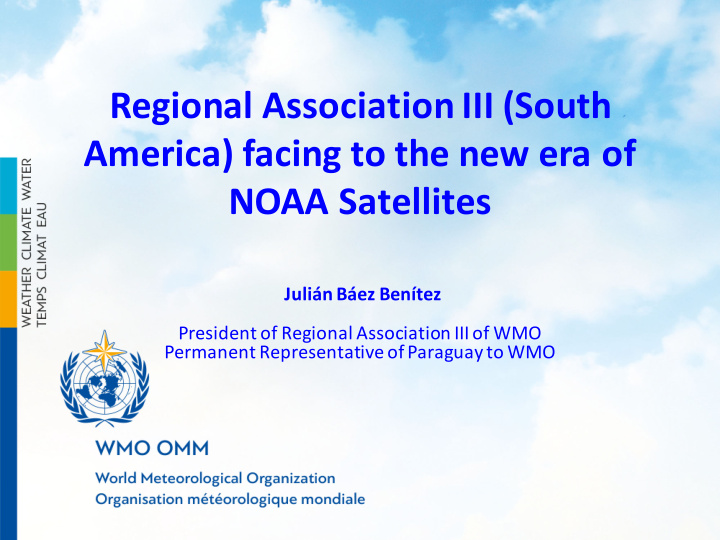



Regional Association III (South America) facing to the new era of NOAA Satellites Julián Báez Benítez President of Regional Association III of WMO Permanent Representative of Paraguay to WMO
Regional Association III (RA-III) of WMO RA-VI RA-II RA-IV RA-III RA-I RA-V Region III: South America - • composed of 12 Member States with capitals in the Region, 1 Member States with capital outside the Region and 0 Member Territories. All countries are represented by • a Meteorological Service and in some cases with hydrological services. www.ar3omm.org
Population Main Soybean Producer Hydropower 390.000.000 hab.
River Basin and Topography of South America JPL - NASA
Meteorological Observation System in RAIII Weather Radar http://wrd.mgm.gov.tr/default.aspx?l=en Surface and Altitude Station https://oscar.wmo.int/surface//index.html#/
Satellite Observations http://www.wmo.int/pages/prog/sat/images/cgms_satellites_1000.jpg
Current use of meteorological satellite in RA III • Geostationary Satellite are the basic tool for monitoring the extreme weather for all NMHS of RAIII. • Some countries use GOES 13 to broadcast automatic weather stations. • Some NMHS use GPM products to monitor daily and monthly precipitation . • Specialized center as CPTEC produce useful information like thunderstone track and fire detection.
Specialized Coordination Group on Satellite for RAIII and RAIV • Regional Coordination Group on Satellite Data Requirements (SDR) was established by WMO in 2015. This group is co-chaired by Luiz Machado (Brazil) and David Bradley (Canada). • In September 2016, the group met in Curacao with the objective to prepare the region for using the new satellite generation. • They discussed the strategies to receive data from the new satellite generation; conducted two surveys; created and updated the list of satellite data requirements for the region; and selected the data the users would like to receive from the new NOAA geostationary.
Specialized Coordination Group on Satellite for RAIII and RAIV • NOAA has sent several GOES-16 experts to the meeting, offering an excellent opportunity for Group members to get first-hand information. • The meeting presented several outcomes as the list of GOES-16 products and channels to be delivered by GNC-A, trainings and actions and recommendations.
SDR Group
Situation of NMHS of RAIII facing the new GOES 16 data and products • In consultation with the NMHS heads, we learned that only Chile had completed the process to implement four GRB station to received GOES 16 data. • Argentina had completed the public tender to buy the new GRB. They expect to implement at the end of this year. • Colombia are in the phase of preparation the documentation for the public tender.
Situation of NMHS of RAIII facing the new GOES 16 data and products • Brazil (INMET), Paraguay and Uruguay will initiate the tender next year. • I have not received yet answer from Bolivia, Peru, Ecuador, Venezuela, but the working group SDR probably have more clear the situation of this countries. • We have not information from Guyana and Surinam.
Temporal Response • Following the recommendation of SDR group, a high percentage of NMHS will use the GeonetCast Americas (GNC-A) as temporal response to assimilate a limited number of bands (7) of GOES 16. • Brazil (INPE), Colombia and Paraguay have, right now, implemented GNC-A. • The rest of the countries of RAIII will implement the GNC-A during this year, due the movement of GOES 13, after GOES 16 be operational.
Needs of education and training • NMHS personnel will need specific training to use the new capabilities of GOES 16. • We expected the support of NOAA to design and implement this training courses. RAIII has three Regional Training Center (RTC) located in Argentina , Brazil and Peru . It has a RTC for hydrology in Venezuela . All this center are open to design specific courses for operational use of the new GOES 16 data.
Needs of education and training • We was informed from the Director of Argentina meteorological service, that they are preparing a semi-presential course “using satellite GOES 16 data” for personnel of SMN of Argentina. • As RTC, Argentina will offer this course, using E-Learning facilities, to the NMHS of RAIII. • We acknowledge the VLab (WMO/NOAA) work in this matter.
Acknowledges • RAIII on behalf of its all NMHS express their special gratitude to NOAA for its decision to move the GOES 16 to east position. This satellite position will help tremendously to NMHS of RAIII to improve their monitoring capacity and forecast to support DRR in their countries and strength their commitment with society. • We acknowledge NOAA for improving the bandwidth (from 2 to 12 MB) for GNC-A, which will allow to disseminate some selected channels of GOES 16 and encourage them to consider the delivery of all bands. • We appreciate the work of WMO/NOAA VLab activities and encourage them to work with the RTC of ARIII.
Acknowledges • Special thanks to WG SDR for their hard work to assess the needs RAI and RAIV Members and recommend the NMHS the best way to adapt to the new technology associated to GOES 16.
Thank you !!
Recommend
More recommend